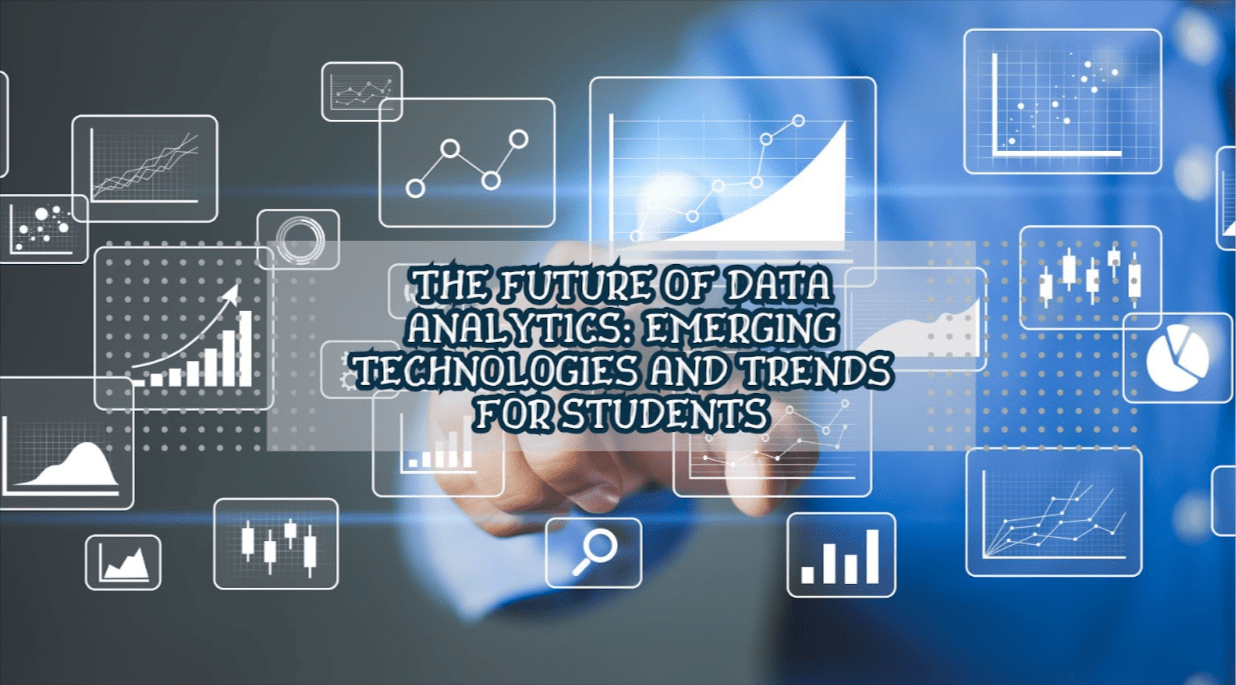
The field of data analytics is dynamic and rapidly evolving, with numerous emerging technologies and trends shaping its trajectory. In this article, we will provide an overview of data analytics and discuss some of the key innovations that are shaping the future of this industry.
Topics we’ll delve into include artificial intelligence, machine learning, cloud computing and blockchain. We will see how this technology is transforming data analytics. Additionally, we will highlight important trends. These include the spread of analytics to more people, real-time analytics, and the rise of data science as a profession.
Are you a student interested in pursuing a career in data analytics, or are you simply curious about the future of this field? This article will introduce you to emerging trends to watch for in the coming years. Now let’s dive in and explore the promising future of data analytics.
What is data analytics?
The process of data analytics involves examining datasets to uncover insights, trends, and patterns that inform decision-making. It encompasses various methodologies, including statistical analysis, machine learning, and predictive modeling, to extract valuable insights from data. The exponential growth of data in today’s digital landscape has rendered data analytics indispensable across industries, providing organizations with actionable insights to drive strategic decisions and gain a competitive edge.
The Role of Python Programming in Data Analytics
Python programming serves as a cornerstone in the field of data analytics, empowering students to leverage advanced tools and techniques for data analysis and visualization. With its intuitive syntax, extensive libraries, and robust community support, Python enables students to explore complex datasets, develop predictive models, and derive actionable insights with ease.
Explore exciting programming jobs that will train you for the future of technology. Furthermore, Python’s interoperability with other programming languages and its compatibility with popular data formats make it an indispensable tool for data scientists and analysts worldwide.
Understanding Data Analytics
At its core, data analytics involves collecting, processing, and analyzing data to extract meaningful insights. Students learn fundamental concepts such as data cleansing, exploratory data analysis, and hypothesis testing to uncover patterns and trends within datasets.
Python programming plays a pivotal role in data analytics, offering a myriad of tools and libraries tailored to various analytical tasks. From data manipulation with Pandas to visualization with Matplotlib and Seaborn, students have access to a rich ecosystem of Python libraries that streamline the data analysis process.
Emerging Technologies in Data Analytics
Artificial Intelligence and Machine Learning in Data Analytics
Artificial intelligence (AI) and machine learning (ML) are revolutionizing data analytics, enabling students to build predictive models, automate processes, and uncover hidden insights within data. Python frameworks like TensorFlow and Scikit-learn provide students with the tools to explore advanced ML algorithms and techniques.
Big Data Analytics
The proliferation of big data presents both challenges and opportunities for students in data analytics. Python frameworks such as Apache Spark and Hadoop enable students to process and analyze large volumes of data efficiently, uncovering actionable insights and driving innovation in diverse industries.
Internet of Things (IoT)
The Internet of Things (IoT) generates vast amounts of data from interconnected devices, creating new avenues for data analytics. Python’s versatility makes it an ideal choice for developing IoT applications, enabling students to collect, analyze, and interpret data from IoT devices to solve real-world problems.
Trends Shaping the Future of Data Analytics
Predictive Analytics
Predictive analytics enables students to forecast future trends and outcomes based on historical data patterns. By leveraging Python programming and advanced statistical techniques, students can build predictive models that inform decision-making and drive business innovation.
Prescriptive Analytics
Prescriptive analytics goes beyond predicting outcomes to recommend actions that optimize results. Python programming enables students to develop prescriptive models that provide actionable insights, helping businesses make informed decisions and achieve strategic objectives.
Edge Computing
Edge computing brings data processing closer to the source of data generation, enabling real-time analysis and decision-making. Python’s lightweight footprint and scalability make it well-suited for edge computing applications, empowering students to build innovative solutions that leverage decentralized data processing.
Data Privacy and Security
As data becomes more abundant, ensuring its privacy and security is paramount. Python programming enables students to implement robust data privacy and security measures, safeguarding sensitive information and maintaining trust with stakeholders.
The Future of Data Analytics: Emerging Trends for Students
Integration with Educational Systems
The integration of data analytics into educational systems is transforming the learning experience for students worldwide. By incorporating Python programming and data analytics concepts into curricula, educators can empower students to develop critical thinking skills, solve real-world problems, and prepare for future careers in data-driven industries.
Career Opportunities in Data Analytics
The future is bright for students with proficiency in data analytics and Python programming. As businesses continue to prioritize data-driven decision-making, the demand for skilled data analysts and Python developers will soar, creating abundant job opportunities across industries.
Importance of Data Analytics for Students
In today’s data-driven world, proficiency in data analytics is a valuable asset for students across disciplines. Whether pursuing careers in business, science, or technology, students equipped with data analytics skills can drive innovation, solve complex problems, and make informed decisions that impact society positively.
Additionally, data analytics fosters critical thinking, problem-solving, and data-driven decision-making skills, preparing students for success in a rapidly evolving job market where data literacy is increasingly valued.
Conclusion
The future of data analytics is filled with exciting potential. The proliferation of data and advancements in technology are leading to innovations that will shape the analytics landscape in the years to come. As a student, being aware of these emerging trends can help you gain relevant skills and experience to stay competitive in the job market.
By keeping up with developments in artificial intelligence, machine learning, cloud computing, and other cutting-edge technologies, aspiring data scientists and analysts can ensure they are prepared for the data-driven roles of tomorrow. The future of the field is bright, and students have an opportunity to be on the leading edge of analytics innovation.
Key Takeaways
- Embrace Python programming as a gateway to data analytics and emerging technologies.
- Explore advanced tools and techniques in data analytics, such as machine learning and big data analytics.
- Stay informed about emerging trends and technologies in data analytics and Python programming.
- Pursue internships, projects, and certifications to gain practical experience and enhance employability in data-driven industries.
FAQs
How can data analytics benefit students beyond the classroom?
Data analytics skills are invaluable for students pursuing careers in various fields, including business, science, engineering, and healthcare, enabling them to analyze data, make informed decisions, and drive innovation.
Are there any prerequisites for learning Python programming and data analytics?
While no prior experience is required, a basic understanding of programming concepts and mathematical principles can be beneficial for learning Python programming and data analytics.
What career paths can students pursue with skills in data analytics and Python programming?
Students proficient in data analytics and Python programming can pursue diverse career paths, including data analyst, machine learning engineer, data scientist, and software developer, across industries such as technology, healthcare, finance, and e-commerce.
How can students stay updated with emerging trends in data analytics and Python programming?
Students can stay informed by following industry blogs, attending conferences, participating in online communities, and exploring open-source projects related to data analytics and Python programming.



